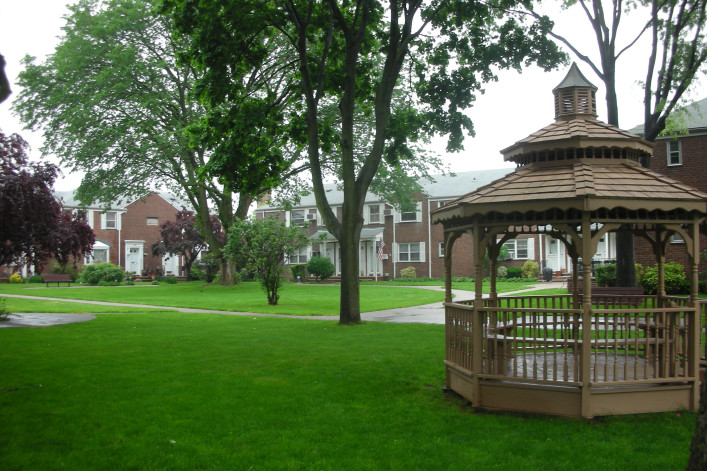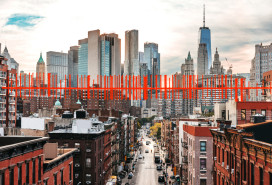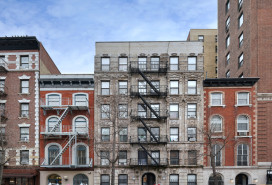5 things you didn't know about Glen Oaks Village, NYC's small town

For those willing to venture to that mysterious region of the city that lies beyond the subway, Glen Oaks, Queens, offers a haven of affordability—and friendliness. The neighborhood is in eastern Queens, right at the Nassau County border; to the west is New Hyde Park, and to the south are Floral Park and Bellerose. Here, you’ll find tree-lined streets and a handful of standalone one- and two-family houses; the idyllic, suburban ambiance makes it hard to believe that you’re still in NYC, especially given that the area is also home to the 47-acre Queens County Farm, the longest continually farmed site in the state.
The area is also dominated by the massive co-op development of Glen Oaks Village—there's also another complex of co-ops nearby called North Shore Towers—that Robert Miller, Glen Oaks Village's on-site broker, says makes up almost the entire neighborhood. We spoke to Miller, as well as a new homeowner, Lauren Harlow, about what makes the neighborhood special.
1. Glen Oaks Village is the largest co-op development in the city, with several options for buyers
Miller notes that Glen Oaks Village is NYC’s biggest co-op development, comprising 2904 garden-style apartments. According to the development’s website, it was originally built for returning veterans in the wake of WWII, and today remains a solidly middle-class community. A New York Times article notes that before the war, the area was primarily farmland—of which the Queens County Farm remains today—but boomed once soldiers came home seeking a place to start families. Glen Oaks Village began as a rental complex for them, and was converted to co-ops in 1981. Unlike the more affluent Queens Village, a neighborhood with a similarly suburban feel, Glen Oaks has been consistently affordable.
Prospective buyers will find eight different styles of apartments, including one-, two-, and three-bedrooms, many of which include outdoor spaces. Harlow and her husband, who have a toddler, purchased a second-floor three-bedroom that includes a large attic. For outdoor space, her building looks out on a huge shared courtyard, where neighbors gather for barbecues in the warm weather.
Price-wise, Miller says that co-op costs range from $180,000 to the mid $300,000s, depending on which of the eight apartment types buyers are seeking. Maintenance fees range from $497 to $788, and include taxes, upkeep, gas, heat, and water.
2. Glen Oaks Village has a neighbor with a fascinating history
About a mile and a half from the development is the Creedmoor Psychiatric Center, a mental health facility with a complicated past. Founded in 1912, its original purpose was to house New Yorkers suffering from mental illness in a more rural environment—in fact, some patients worked on the Queens County Farm, a practice thought to be therapeutic for them. The hospital’s population skyrocketed in later years, and Creedmoor gained a reputation for treating its residents with negligence and brutality, a scandal that was chronicled by the New York Times.
The hospital still exists today, though it’s much smaller; its official site says its mission is “to provide compassionate, high quality mental health services for Queens County residents.” One of the buildings on its campus was abandoned in the 1970s, and Atlas Obscura went inside this spooky site, which seems ready-made for a horror movie.
Fortunately, Glen Oaks also has a medical institution with a much less sordid history—the Long Island Jewish Medical Center is just to the north, in New Hyde Park.

3. Homeowners have an unusual amount of freedom
Glen Oaks Village is different from all other co-ops, Miller says: “Aside from normal amenities, here you can add on to your apartment. You can add another floor to the apartment if it’s upstairs, or reclaim the basement if it’s on the ground floor.”
Harlow says this level of flexibility was a huge part of her new home’s appeal. Her husband works in construction, which means “we can turn our attic into a loft if we want to.” They had previously looked at a number of co-op neighborhoods, but “were disappointed with the rules regarding renovations,” Harlow says. “Here, the community looks so much less institutional, because there are little differences and personal touches that are encouraged.”
Miller also notes the decks, patios, and gardens that lend vibrancy to the development. “It’s homeownership without the headache,” he says.
4. It’s in the highest-rated school district in the city.
Glen Oaks is part of District 26, which according to Inside Schools is New York City’s highest-achieving school district. At the local elementary and middle school P.S./I.S. 266, students score well above the citywide average on state ELA and science exams—for instance, 84 percent of eighth graders got a 3 or 4 on standardized science test, versus the NYC average of 57 percent. Several of the local elementary schools offer gifted and talented programs, and the Queens High School of Teaching, Liberal Arts and the Sciences is respected for its inclusion programs integrating students with disabilities.
Two elementary schools are within walking distance from wherever tenants live in the development, and their stellar reputation attracted Harlow. “It’s a huge pull,” she says. “There are a lot of young families coming here, and it’s like being in Queens but going to schools in Nassau County.”
5. It’s a unique blend of city and suburban living, with a strong sense of community
Glen Oaks’ blend of New York City and Long Island is, for some, the best of both worlds—especially when it comes to finances. “Because it’s on the Queens side, the taxes are lower,” Miller says. “And the maintenance is substantially lower than it is on the Nassau side.” According to SmartAsset, the average Nassau County property tax is 2.13 percent, versus 0.75 percent in Queens.
Given that the community isn’t near a subway, many residents own cars, and Miller says parking is easy and cheap: “You can have multiple cars in a household and still be able to park.” Parking on an outdoor back lot is a mere $25 a year, while an indoor parking space will run you $35 a month. The co-op is also served by local and express buses, and is two miles from the Floral Park Long Island Rail Road station.
When residents go out to eat or shop, they tend to do so on both the city and Nassau County sides. Miller notes that the next town over, Lake Success, has a shopping center and numerous pizzerias, Italian restaurants, and Latin American spots; locals also head to Bell Boulevard in Bayside, which has many trendy stores and ethnic eateries serving everything from Greek to Taiwanese.
Harlow says she’s charmed by Glen Oaks Village’s motto, a holdover from when it was first built in the 1950s: “Glen Oaks, Fine Folks.” That quaint tone extends to how residents socialize, with plenty of community-oriented organizations and activities, like a gardening club, softball team, and dog meet-ups. Harlow, who has a pitbull-boxer mix, is pleased by how dog-friendly the co-op is: “They actually have pet events, which you don’t get anywhere else.”
Miller adds that the sense of togetherness is especially noticeable in the summer, when neighbors set out kiddie pools for their children and get together for barbecues. “It’s one of the friendliest places that you’ll ever see as a community—it’s hard to put that into words,” he says.
Related:
The safest and most dangerous neighborhoods in NYC


























